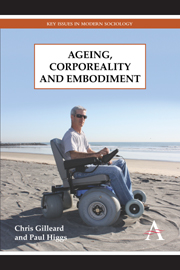Book contents
- Frontmatter
- Contents
- Introduction
- Chapter 1 Identity, Embodiment and the Somatic Turn in the Social Sciences
- Chapter 2 Corporeality, Embodiment and the ‘New Ageing’
- Chapter 3 Gender, Ageing and Embodiment
- Chapter 4 Age and the Racialised Body
- Chapter 5 Disability, Ageing and Identity
- Chapter 6 Sexuality, Ageing and Identity
- Chapter 7 Sex and Ageing
- Chapter 8 Cosmetics, Clothing and Fashionable Ageing
- Chapter 9 Fitness, Exercise and the Ageing Body
- Chapter 10 Ageing and Aspirational Medicine
- Conclusions: Ageing, Forever Embodied
- References
- Index
- ADVANCE PRAISE
Chapter 9 - Fitness, Exercise and the Ageing Body
Published online by Cambridge University Press: 05 July 2013
- Frontmatter
- Contents
- Introduction
- Chapter 1 Identity, Embodiment and the Somatic Turn in the Social Sciences
- Chapter 2 Corporeality, Embodiment and the ‘New Ageing’
- Chapter 3 Gender, Ageing and Embodiment
- Chapter 4 Age and the Racialised Body
- Chapter 5 Disability, Ageing and Identity
- Chapter 6 Sexuality, Ageing and Identity
- Chapter 7 Sex and Ageing
- Chapter 8 Cosmetics, Clothing and Fashionable Ageing
- Chapter 9 Fitness, Exercise and the Ageing Body
- Chapter 10 Ageing and Aspirational Medicine
- Conclusions: Ageing, Forever Embodied
- References
- Index
- ADVANCE PRAISE
Summary
In Chapter 9 we turn from the body work associated with cosmetics, self-care, dress and fashion to a consideration of fitness and physical exercise and their role as forms of body work directed toward ‘not becoming old’. While physical activity has conventionally been associated with youth, changes over the last half century have seen exercise and fitness become not only commodified, but also incorporated into the new discourses of ageing. Among the many factors that distinguish exercise from other body practices is its engagement with the idea of fitness as both an interior and exterior virtue. In its attention to both the internal self and civic virtue, physical exercise has long been part of the care and cultivation of the self. Alongside medicine, cosmetics and the ‘sensual arts’, it formed part of the quartet of human sciences addressing what the philosopher Francis Bacon described as ‘the good of man's body’ (Bacon 2002). Of course, this is not to claim that such sciences have not changed over time. In contemporary society, exercise has become a more ‘individualised’ and a more ‘fashioned’ aspect of lifestyle through which social distinction is sought and interpreted. It may be over-stretching a point to claim that this may represent a continuous link with the regimes and practices that promote health, functioning and beauty known by Galen as gymnasia (Galen 1997). These regimes were described as activities of ‘child training’, creating the conditions of health fitness and beauty in youth.
- Type
- Chapter
- Information
- Ageing, Corporeality and Embodiment , pp. 131 - 144Publisher: Anthem PressPrint publication year: 2013



